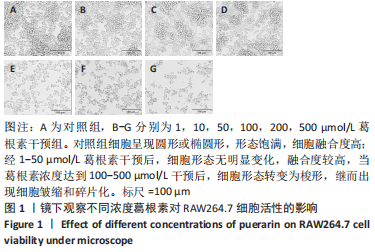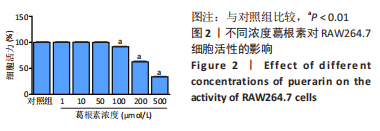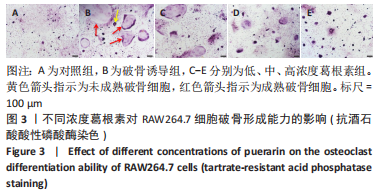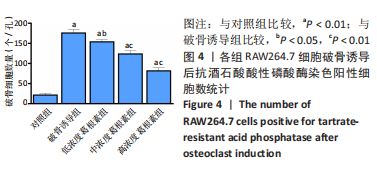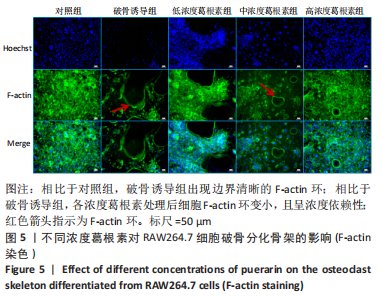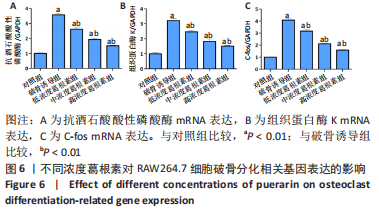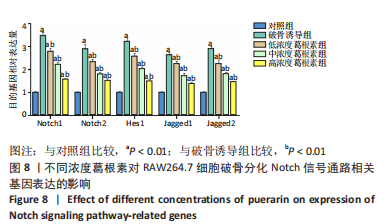Chinese Journal of Tissue Engineering Research ›› 2023, Vol. 27 ›› Issue (32): 5114-5119.doi: 10.12307/2023.829
Previous Articles Next Articles
Effects of puerarin on osteoclast differentiation of RAW264.7 cells
Liu Chunli, Yan Yujuan, Mo Liwen, Wu Zhijie, Zhang Li
- School of Stomatology, Hainan Medical University, Haikou 571101, Hainan province, China
-
Received:2022-10-25Accepted:2022-12-28Online:2023-11-18Published:2023-03-23 -
Contact:Zhang Li, Associate professor, School of Stomatology, Hainan Medical University, Haikou 571101, Hainan province, China -
About author:Liu Chunli, Attending physician, School of Stomatology, Hainan Medical University, Haikou 571101, Hainan province, China -
Supported by:Hainan Provincial Finance Fund for Science and Technology Program - 2020 Hainan Province Key R&D Program for Social Development, No. ZDYF2020166 (to ZL)
CLC Number:
Cite this article
Liu Chunli, Yan Yujuan, Mo Liwen, Wu Zhijie, Zhang Li. Effects of puerarin on osteoclast differentiation of RAW264.7 cells[J]. Chinese Journal of Tissue Engineering Research, 2023, 27(32): 5114-5119.
share this article
Add to citation manager EndNote|Reference Manager|ProCite|BibTeX|RefWorks

2.5 葛根素通过抑制Notch信号通路抑制破骨细胞形成 Notch信号通路的过度活跃可以促进RANKL入核,进而促进RAW264.7细胞向破骨细胞分化。实验分别采用Western blot和RT-PCR法检测葛根素干预后RAW264.7细胞破骨诱导分化后Notch信号通路蛋白及基因的表达情况。 Western blot检测结果显示,破骨诱导可以激活Notch信号通路,与对照组相比,破骨诱导组Notch1、Notch2、Hes1、Jaggde1、Jaggde2蛋白表达量均显著上调(P < 0.01);与破骨诱导组相比,各浓度葛根素组Notch1、Notch2、Hes1、Jaggde1、Jaggde2蛋白表达量显著降低(P < 0.01),且呈浓度依赖性,见图7。RT-PCR检测结果趋势与Western blot检测结果一致,均显示破骨诱导可以上调Notch信号通路相关蛋白表达,葛根素可以抑制Notch信号通路,见图8。"
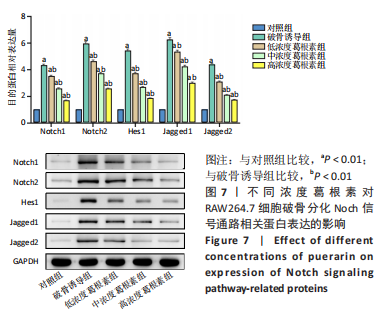
| [1] NAKASHIMA T, HAYASHI M, TAKAYANAGI H. New insights into osteoclastogenic signaling mechanisms. Trends Endocrin Met. 2012;23(11):582-590. [2] KIM H, LEE K, KIM JM, et al. Selenoprotein W ensures physiological bone remodeling by preventing hyperactivity of osteoclasts. Nat Commun. 2021;12:2258. [3] 任明诗,丁羽,李子涵,等.成骨细胞与破骨细胞相互调节作用的研究进展[J].中国药理学通报,2022,38(6):822-827 [4] DA W, TAO L, ZHU Y. The Role of Osteoclast Energy Metabolism in the Occurrence and Development of Osteoporosis. Front Endocrinol. 2021; 12:675385. [5] LEWIECKI, MICHAEL E. New targets for intervention in the treatment of postmenopausal osteoporosis. Nat Rev Rheumatol. 2011;7(11):631-638. [6] KAZUHIRO Y, KOJIRO S, TAKASHI M, et al. Characterization and Function of Tumor Necrosis Factor alpha and Interleukin-6-Induced Osteoclasts in Rheumatoid Arthritis. Arthritis Rheumatol. 2021;73(7):1145-1154. [7] CHEN X, WANG ZQ, DUAN NA, et al. Osteoblast-osteoclast interactions. Connect Tissue Res. 2018;59(2):99-107. [8] RACZ GZ, KADAR K, FOLDES A, et al. Immunomodulatory and potential therapeutic role of mesenchymal stem cells in periodontitis. J Physiol Pharmacol. 2014;65(3):327-339. [9] SIEBEL C, LENDAHL U. Notch Signaling in Development, Tissue Homeostasis, and Disease. Physiol. 2017;97(4):1235-1294. [10] RAPHAEL K, MA XL. The Canonical Notch Signaling Pathway: Unfolding the Activation Mechanism. Cell. 2009;137:216-233. [11] YU J, CANALIS E. Notch and the Regulation of Osteoclast Differentiation and Function. Bone. 2020;138:115474. [12] ZHAO B, GRIMES SN, LI S, et al. TNF-induced osteoclastogenesis and inflammatory bone resorption are inhibited by transcription factor RBP-J. J Exp Med. 2012;209(2):319-34. [13] FUJIWARA T, ZHOU J, YE S, et al. RNA-binding protein Musashi2 induced by RANKL is critical for osteoclast surviva. Cell Death Dis. 2016;7:e2300. [14] 张峻玮,李琰,薛海鹏,等.骨碎补经骨髓间充质干细胞调节OPG/RANKL/RANK通路抑制破骨细胞的实验研究[J].中国骨质疏松杂志, 2019,25(5):617-624. [15] 王东红,王春爱,薛建军.葛根素的研究进展[J].西部中医药,2017, 30(1):139-142. [16] 杨一秋,李兰,解继胜,等.葛根素介导PTEN-PI3K-AKT信号通路抑制绝经后骨质疏松症的机制研究[J]. 中国骨质疏松杂志,2022,28(3): 347-351. [17] WONG R, RABIE B. Effect of puerarin on bone formation. Osteoarthritis Cartilage. 2007;15(8):894-899. [18] 周帅,芦山,郭森.基于Notch信号通路探究葛根素对肺动脉高压小鼠治疗作用机制研究[J].辽宁中医杂志,2022,49(7):197-200. [19] PARK J, ZHANG X, LEE S K, et al. CCL28-induced RARβ expression inhibits oral squamous cell carcinoma bone invasion. J Clin Invest. 2019;129(12):5381-5399. [20] ONO T, NAKASHIMA T. Recent Advances in Osteoclast Biology.Histochem Cell Biol. 2018;149:325-341. [21] LARROUTURE QC, CRIBBS AP, RAO S R, et al. Loss of mutual protection between human osteoclasts and chondrocytes in damaged joints initiates osteoclast-mediated cartilage degradation by MMPs. Sci Rep. 2021;11:22708. [22] AMIN N, BOCCARDI V, TAGHIZADEH M, et al. Probiotics and bone disorders: the role of RANKL /RANK/OPG pathway. Aging Clin Exp Res. 2020;32(3):363-371. [23] 詹乐,马瑞堉,万妮,等.葛根素对牙周炎大鼠Th17/Treg细胞免疫平衡及相关转录因子表达的影响[J]. 昆明医科大学学报,2022, 43(11):36-43. [24] 高陆,刘欧胜,徐丽.司马西特通过Notch/RANKL诱导破骨细胞形成的初步研究[J].口腔生物医学,2021,12(3):160-165. [25] 季开心,陈思言,张敏杰,等.坏死性凋亡在大鼠牙移动过程中对牙周组织改建的影响[J].口腔医学,2021,41(12):1068-1087. [26] MIZUKAMI J, TAKAESU G, AKATSUKA H, et al. Receptor activator of NF-kappaB ligand (RANKL) activates TAK1 mitogen-activated protein kinase kinase kinase through a signaling complex containing RANK, TAB2, and TRAF6. Mol Cell Biol. 2002;22(4):992-1000. [27] YAMAMOTO A, MIYAZAKI T, KADONO Y, et al. Possible Involvement of IκB Kinase 2 and MKK7 in Osteoclastogenesis Induced by Receptor Activator of Nuclear Factor κB Ligand. J Bone Miner Res. 2002;17(4): 612-621. [28] 闫波.葛根素抑制PMMA颗粒诱导破骨细胞形成及骨溶解的机制研究[D].郑州:郑州大学,2020. [29] 于冬冬,赵丹阳,姚啸生,等.葛根素通过NF-κB信号通路调节破骨细胞的分化[J].中国骨质疏松杂志,2019,25(9):837-841. [30] 袁斯远,何芳,孔蓓蓓,等.葛根素对破骨细胞形成以及成骨细胞OPG/RANKL mRNA表达的影响[J].中华中医药杂志,2015,30(11): 3889-3892. [31] FILIPOVIC M, FLEGAR D, SUCUR A, et al. Inhibition of Notch Signaling Stimulates Osteoclastogenesis From the Common Trilineage Progenitor Under Inflammatory Conditions. Front Immunol. 2022;13:902947. [32] 刘官娟,宋娜,霍花,等.唑来膦酸调控NLRP3信号通路抑制脂多糖诱导的破骨细胞分化[J].中国组织工程研究,2023,27(29):4677-4683. [33] 冯燕陵.FoxO1介导白藜芦醇、葛根素抑制破骨细胞生成和活性的机制研究[D].兰州:兰州大学,2018. [34] 康鑫.葛根素促进成骨细胞增殖及信号调控机制的实验研究[D].兰州:兰州大学,2015. [35] ARMSTRONG AP, TOMETSKO ME, GLACCUM M, et al. A RANK/TRAF6-dependent signal transduction pathway is essential for osteoclast cytoskeletal organization and resorptive function. J Biol Chem. 2002; 277(46):44347-44356. [36] ZHOU B, LIN W, LONG Y, et al. Notch signaling pathway:architecture, disease,and therapeutics. Signal Transduct Target Ther. 2022;7(1):95. [37] ZENG XZ, HE LG, WANG S, et al. Aconine inhibits RANKL-in-duced osteoclast differentiation in RAW264.7 cells by suppressing NF-κB and NFATc1 activation and DC-STAMP expression. Acta Pharmacol Sin. 2016; 37(2):255-263. [38] WANG ZW, LI YW, SARKAR FH. Notch Signaling Proteins: Legitimate Targets for Cancer Therapy. Curr Protein Pept Sci. 2010;11(6):398-408. [39] 平依林,娄锋,杨肖,等. Notch1蛋白高表达抑制破骨细胞增殖和分化[J].华西口腔医学杂志,2016,34(2):121-124. [40] 王汝杰,刘复州,沈伟伟,等. Jagged1活化Notch通路促进RAW 264.7向破骨细胞分化但抑制增殖[J]. 中国免疫学杂志,2014,30(7): 865-869. |
| [1] | Dang Yi, Du Chengyan, Yao Honglin, Yuan Nenghua, Cao Jin, Xiong Shan, Zhang Dingmei, Wang Xin. Hormonal osteonecrosis and oxidative stress [J]. Chinese Journal of Tissue Engineering Research, 2023, 27(9): 1469-1476. |
| [2] | Yang Zhishan, Tang Zhenglong. YAP/TAZ, a core factor of the Hippo signaling pathway, is involved in bone formation [J]. Chinese Journal of Tissue Engineering Research, 2023, 27(8): 1264-1271. |
| [3] | Long Guiyue, Li Dongdong, Liao Hongbing. Calcium phosphate cement/poly(lactic-co-glycolic acid) degradation products promote osteoclast differentiation of mouse monocytes [J]. Chinese Journal of Tissue Engineering Research, 2023, 27(8): 1193-1198. |
| [4] | Tang Liang, Li Xiheng, Niu Ruijuan, Li Xinyue, Zou Xinying, Mao Tianjiao, Li Jiang. Naringin regulates the function of RAW264.7 macrophages to affect the osteogenic differentiation of MC-3T3-E1 cells [J]. Chinese Journal of Tissue Engineering Research, 2023, 27(8): 1205-1210. |
| [5] | Huang Linke, Wei Linhua, Jiang Jie, Liu Qian, Chen Weiwei. Effects of estrogen combined with treadmill exercise on bone mass and articular cartilage in ovariectomized mice [J]. Chinese Journal of Tissue Engineering Research, 2023, 27(8): 1166-1171. |
| [6] | Qiao Luhui, Ma Ziyu, Guo Haoyu, Hou Yudong. Comparison of puerarin and icariin on the biological properties of mouse preosteoblasts [J]. Chinese Journal of Tissue Engineering Research, 2023, 27(6): 872-877. |
| [7] | Zhang Min, Zhang Xiaoming, Liu Tongbin. Application potential of naringin in bone tissue regeneration [J]. Chinese Journal of Tissue Engineering Research, 2023, 27(5): 787-792. |
| [8] | Mo Yaomin, Liu Pan, Ma Ruixin, Zeng Gaofeng, Zong Shaohui. Mechanism of paroxetine on osteoclast differentiation [J]. Chinese Journal of Tissue Engineering Research, 2023, 27(32): 5184-5190. |
| [9] | Wang Huida, Sun Xiaotong, Bi Lan, Wang Zixuan, Zhang Ronghe. Effect of astragalus polysaccharides on orthodontic bone remodeling [J]. Chinese Journal of Tissue Engineering Research, 2023, 27(32): 5214-5218. |
| [10] | Han Jie, Lin Zhiyu, Xu Zhiwei, Zhang Xiaoyun, Shang Yuzhi, Liu Hao. Interventional effect of microRNA on osteonecrosis of the femoral head through bone metabolism mechanism [J]. Chinese Journal of Tissue Engineering Research, 2023, 27(32): 5238-5248. |
| [11] | Liu Guanjuan, Xia Qianxi, Song Na, Huo Hua, Hong Wei, Liao Jian. Role of pyruvic acid in osteoclast differentiation [J]. Chinese Journal of Tissue Engineering Research, 2023, 27(31): 5015-5021. |
| [12] | Shen Mengran, Ren Yansong, Zhou Yu, Yue Debo, Ma Jinhui, Wang Bailiang. Interleukin-33-mediated bone immunity [J]. Chinese Journal of Tissue Engineering Research, 2023, 27(29): 4723-4728. |
| [13] | Wei Zongbo, Su Yunyu, Zhang Xiaoyun, Huang Wei, Xu Hang, Liu Rongfa. Role and mechanism by which long non-coding RNAs regulate subchondral bone homeostasis in knee osteoarthritis [J]. Chinese Journal of Tissue Engineering Research, 2023, 27(29): 4736-4744. |
| [14] | Liu Guanjuan, Song Na, Huo Hua, Luo Shanshan, Cheng Yuting, Xiong Yue, Hong Wei, Liao Jian. Zoledronic acid inhibits lipopolysaccharide-induced osteoclast differentiation by regulating NLRP3 signaling pathway [J]. Chinese Journal of Tissue Engineering Research, 2023, 27(29): 4677-4683. |
| [15] | Zhang Bowen, Li Mei, Zhang Jinning, Yang Tianxiang, Cheng Mengqi, Chen Desheng. Tetrandrine inhibits osteoclast differentiation by inducing autophagy [J]. Chinese Journal of Tissue Engineering Research, 2023, 27(28): 4473-4479. |
| Viewed | ||||||
|
Full text |
|
|||||
|
Abstract |
|
|||||

